Nature reserves in Portugal offer a unique opportunity to explore rich biodiversity and engage in various outdoor activities. Discover diverse ecosystems, from Mediterranean forests to coastal wetlands, while observing rare wildlife like the Iberian wolf. Seasonal changes enhance visitor experiences, with vibrant blooms in spring and unique birdwatching opportunities in winter. Essential visitor information, including park hours and recommended gear, ensures a fulfilling trip while cultural and historical elements deepen the connection to these natural spaces.
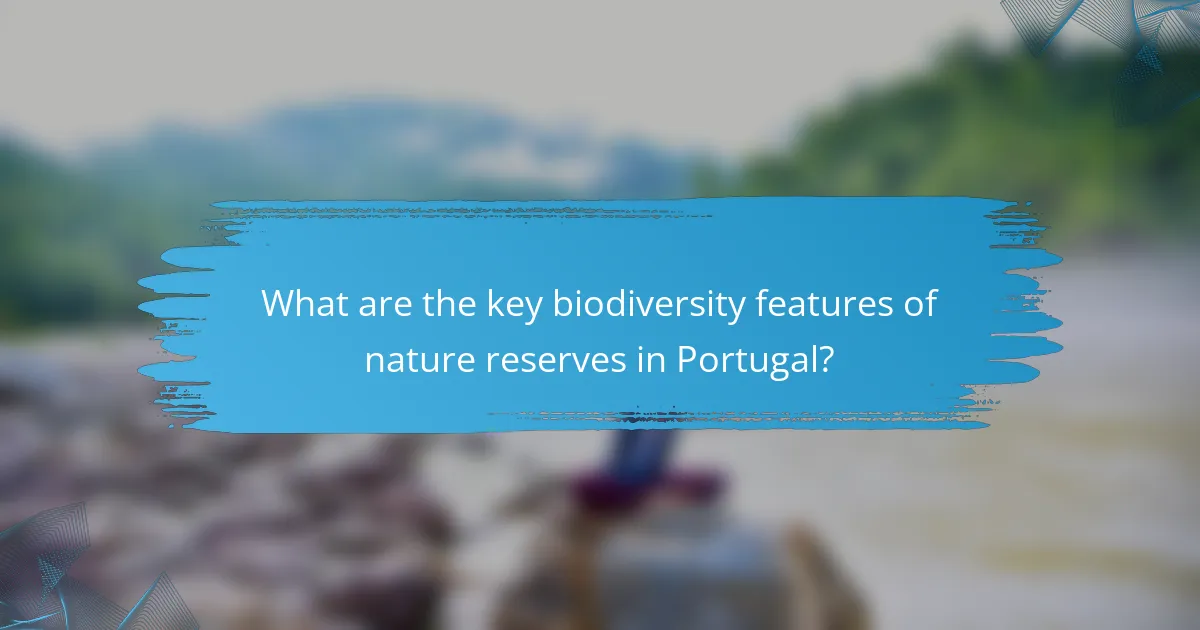
What are the key biodiversity features of nature reserves in Portugal?
Nature reserves in Portugal showcase rich biodiversity, featuring unique ecosystems and endemic species. Key biodiversity features include diverse flora, such as Mediterranean shrubs and cork oak forests, and fauna like the Iberian wolf and various bird species. These reserves also support significant habitats, including wetlands and coastal areas, which are crucial for migratory birds. Conservation efforts in these areas aim to protect this biodiversity while promoting sustainable tourism and educational activities.
Which species are endemic to Portugal’s nature reserves?
Several species are endemic to Portugal’s nature reserves, including the Iberian wolf, the Iberian magpie, and the Portuguese water dog. These species thrive in unique habitats found within the country’s diverse ecosystems. The Iberian wolf, for instance, plays a crucial role in maintaining ecological balance, while the Iberian magpie is notable for its distinctive plumage. The Portuguese water dog, a unique breed, is well-adapted to the coastal regions. These endemic species contribute significantly to Portugal’s biodiversity and are often the focus of conservation efforts.
How do the ecosystems vary across different regions?
Ecosystems in Portugal vary significantly due to diverse climates, topographies, and human influences. Coastal regions host marine ecosystems with rich biodiversity, while inland areas feature unique forest and mountain habitats. The Mediterranean climate supports a variety of plant species, contributing to the country’s ecological diversity. Nature reserves, such as the Ria Formosa and Peneda-Gerês, showcase distinct ecosystems, providing habitats for numerous endemic species. These variations enhance Portugal’s appeal for biodiversity enthusiasts and nature lovers.
What conservation efforts are in place for biodiversity protection?
Portugal has implemented various conservation efforts to protect its biodiversity, primarily through the establishment of nature reserves. These reserves safeguard unique ecosystems and species. Key initiatives include habitat restoration, species monitoring, and community engagement in conservation activities. The Natura 2000 network encompasses numerous protected areas, ensuring the preservation of critical habitats and species. Additionally, educational programs promote awareness and encourage sustainable tourism practices.
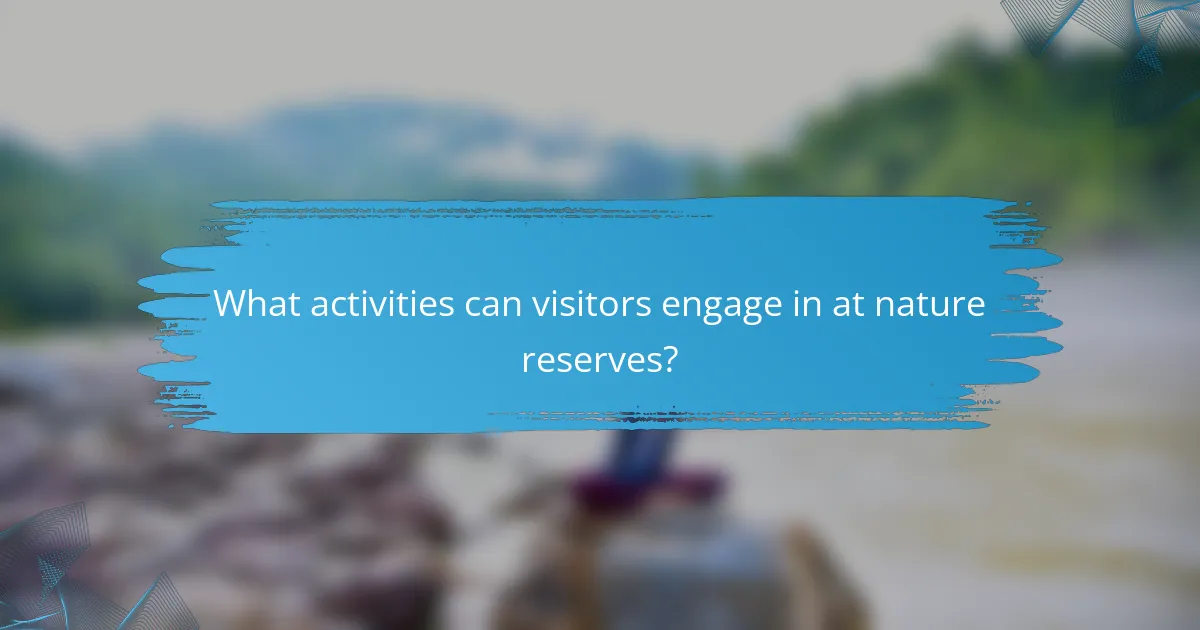
What activities can visitors engage in at nature reserves?
Visitors at nature reserves in Portugal can engage in various activities such as hiking, birdwatching, photography, and educational tours. These experiences highlight the rich biodiversity and unique landscapes of the reserves. Hiking trails often vary in difficulty, catering to all skill levels. Birdwatching opportunities are abundant, with many reserves home to rare species. Educational tours provide insights into conservation efforts and local ecology, enhancing visitor knowledge and appreciation. Overall, these activities promote environmental awareness and enjoyment of nature.
Which outdoor activities are most popular among visitors?
Hiking, birdwatching, and photography are among the most popular outdoor activities in Portugal’s nature reserves. These activities allow visitors to engage with the rich biodiversity and stunning landscapes. Hiking trails often vary in difficulty, catering to both beginners and experienced adventurers. Birdwatching attracts enthusiasts due to the diverse avian species found in these reserves. Photography opportunities abound, showcasing the unique flora and fauna.
How can visitors participate in guided tours and educational programs?
Visitors can participate in guided tours and educational programs by registering online or at visitor centers. Nature reserves in Portugal offer diverse activities that promote biodiversity awareness. Programs often include expert-led tours, workshops, and interactive sessions. Check specific reserve websites for schedules and booking details.
What are the best practices for responsible tourism in nature reserves?
Responsible tourism in nature reserves emphasizes minimizing environmental impact while enhancing visitor experiences. Best practices include following marked trails to protect habitats, observing wildlife from a distance, and avoiding littering. Visitors should also respect local cultures and engage in educational programs. Supporting conservation efforts through donations or volunteer work further promotes sustainability. Lastly, utilizing eco-friendly transportation options reduces carbon footprints and preserves the natural beauty of these areas.
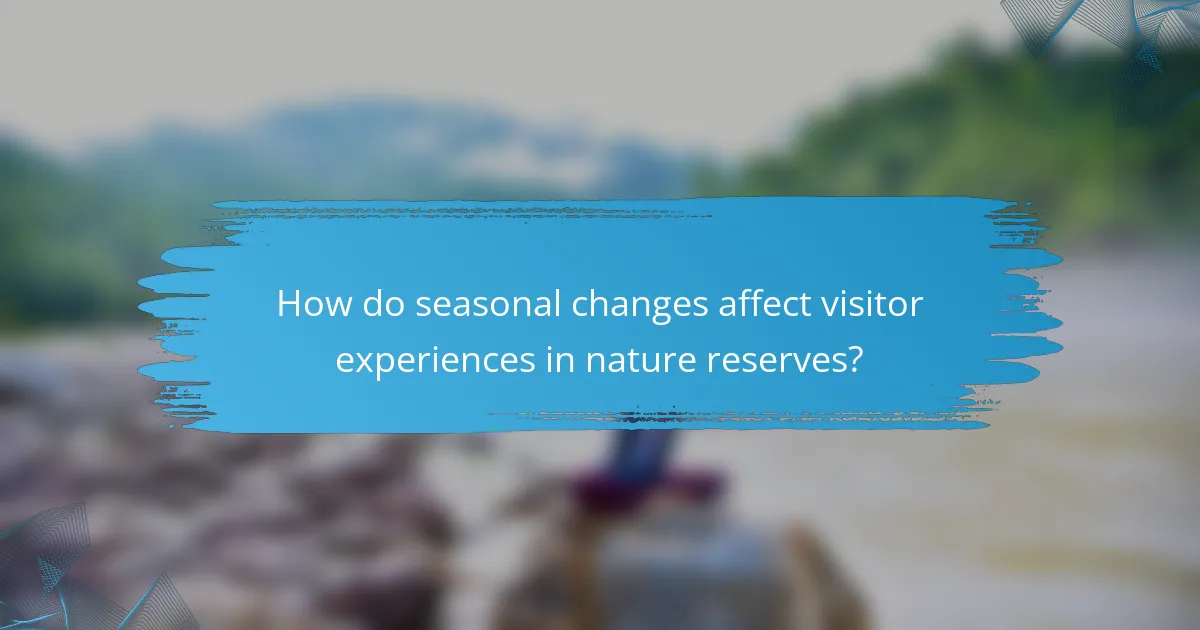
How do seasonal changes affect visitor experiences in nature reserves?
Seasonal changes significantly influence visitor experiences in nature reserves. Spring brings vibrant blooms and active wildlife, attracting many visitors. Summer offers longer days for exploration, but heat may deter some. Autumn showcases stunning foliage, while winter presents unique opportunities for birdwatching and tranquility. Understanding these seasonal dynamics enhances visitor satisfaction and engagement.
What wildlife can be observed during different seasons?
Various wildlife can be observed in Portugal’s nature reserves throughout the seasons. In spring, migratory birds return, and wildflowers bloom, attracting insects. Summer showcases vibrant fauna, including reptiles and mammals. Autumn brings migratory species, while winter offers sightings of resident birds and unique mammals. Each season presents distinct opportunities for wildlife observation.
How do weather conditions influence activities and accessibility?
Weather conditions significantly influence activities and accessibility in nature reserves. For instance, sunny days encourage hiking and birdwatching, while rain may limit outdoor activities. Seasonal changes affect wildlife visibility and plant blooming, enhancing visitor experiences. Additionally, extreme weather can restrict access due to safety concerns. Understanding these factors helps visitors plan their trips effectively.
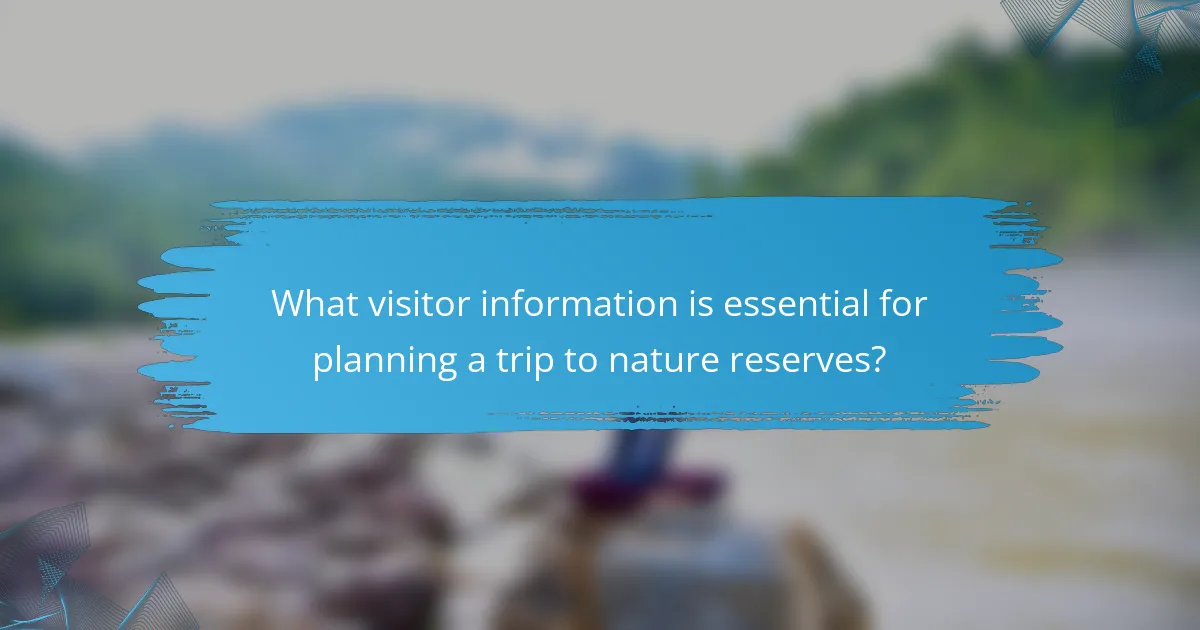
What visitor information is essential for planning a trip to nature reserves?
Essential visitor information for planning a trip to nature reserves includes park hours, entry fees, available activities, and recommended gear. Understanding the biodiversity and unique features of each reserve enhances the experience. Additionally, knowing the best times to visit can optimize wildlife sightings and outdoor activities.
Which facilities and amenities are available for visitors?
Nature reserves in Portugal offer various facilities and amenities for visitors. Common features include visitor centers, picnic areas, guided tours, and educational programs. Many reserves provide hiking trails, observation points, and restrooms. Some locations may also have accommodations for overnight stays. Accessibility options are often available to ensure all visitors can enjoy the natural beauty.
How can visitors prepare for their visit in terms of safety and regulations?
Visitors can prepare for their visit by understanding safety guidelines and regulations. Familiarize yourself with park rules, such as staying on marked trails and respecting wildlife. Bring necessary supplies like water, first aid kits, and appropriate clothing for weather conditions. Check for any specific regulations regarding fires, camping, and pet policies in the nature reserve. Always follow local guidelines to ensure a safe and enjoyable experience.
What are the best times to visit for optimal experiences?
The best times to visit nature reserves in Portugal for optimal experiences are during spring and autumn. These seasons offer mild weather, vibrant flora, and active wildlife, enhancing outdoor activities. Spring, particularly from March to May, showcases blooming flowers and migratory birds. Autumn, from September to November, provides stunning foliage and comfortable temperatures for hiking and exploration.
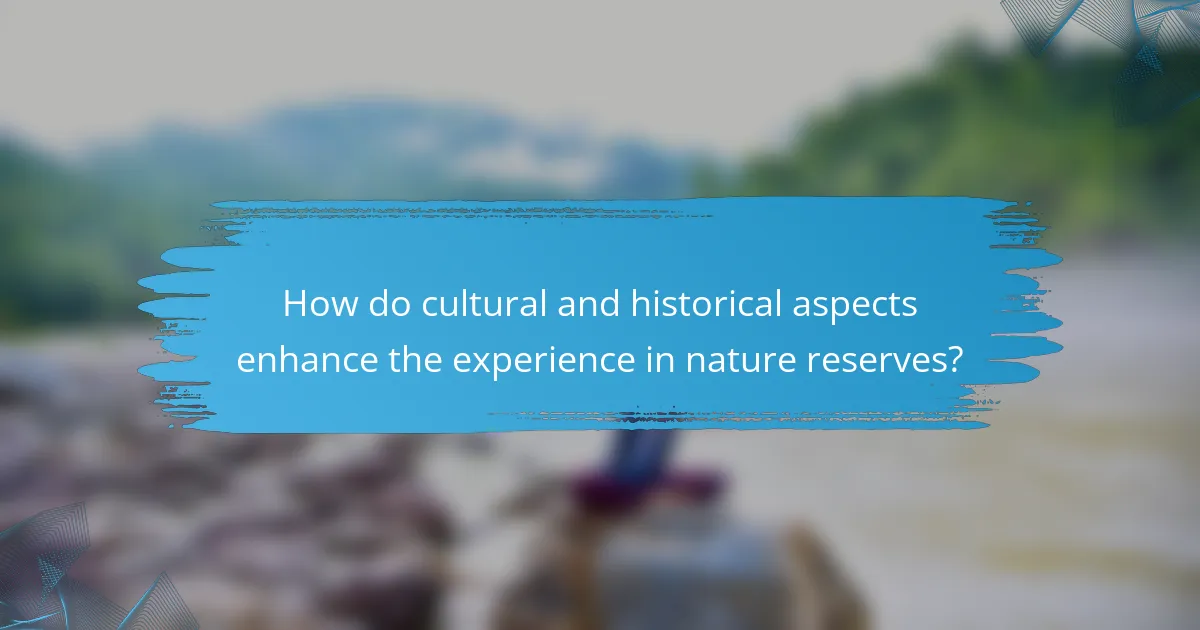
How do cultural and historical aspects enhance the experience in nature reserves?
Cultural and historical aspects significantly enhance the experience in nature reserves by providing deeper connections to the landscape. In Portugal, these elements enrich visitor engagement through storytelling, traditions, and local heritage.
Nature reserves often showcase historical landmarks, such as ancient ruins or traditional farming practices, which highlight the relationship between people and nature. This context fosters appreciation for biodiversity and conservation efforts.
Cultural events and guided tours further immerse visitors in local customs, enhancing their understanding of the ecosystem. For example, local festivals may celebrate seasonal changes, linking cultural identity with environmental awareness.
Overall, the integration of cultural and historical narratives transforms nature reserves into dynamic spaces where visitors can explore both natural beauty and human history.
What local traditions and practices are influenced by the natural environment?
Local traditions and practices in Portugal are significantly influenced by its diverse natural environments. The country’s nature reserves, such as the Ria Formosa and Arrábida, shape local customs, culinary practices, and festivals.
For example, fishing communities in Ria Formosa rely on the lagoon’s biodiversity, which informs their traditional fishing methods and seasonal celebrations. Similarly, the Arrábida region’s lush landscapes inspire local artisans, who create crafts reflecting the area’s flora and fauna.
Additionally, the preservation of these natural sites fosters eco-tourism, promoting sustainable practices and community engagement. This connection between the environment and local culture highlights the importance of biodiversity in shaping Portuguese identity.
Which historical sites are located within or near nature reserves?
Several historical sites are located within or near nature reserves in Portugal. Notable examples include the Arrábida Natural Park, which is home to the 16th-century Convent of Our Lady of Arrábida. The Ria Formosa Natural Park features the historic town of Faro, with its ancient city walls and cathedral. Additionally, the Peneda-Gerês National Park contains the medieval village of Lindoso, known for its traditional granaries. These sites highlight the rich cultural heritage intertwined with Portugal’s natural landscapes.
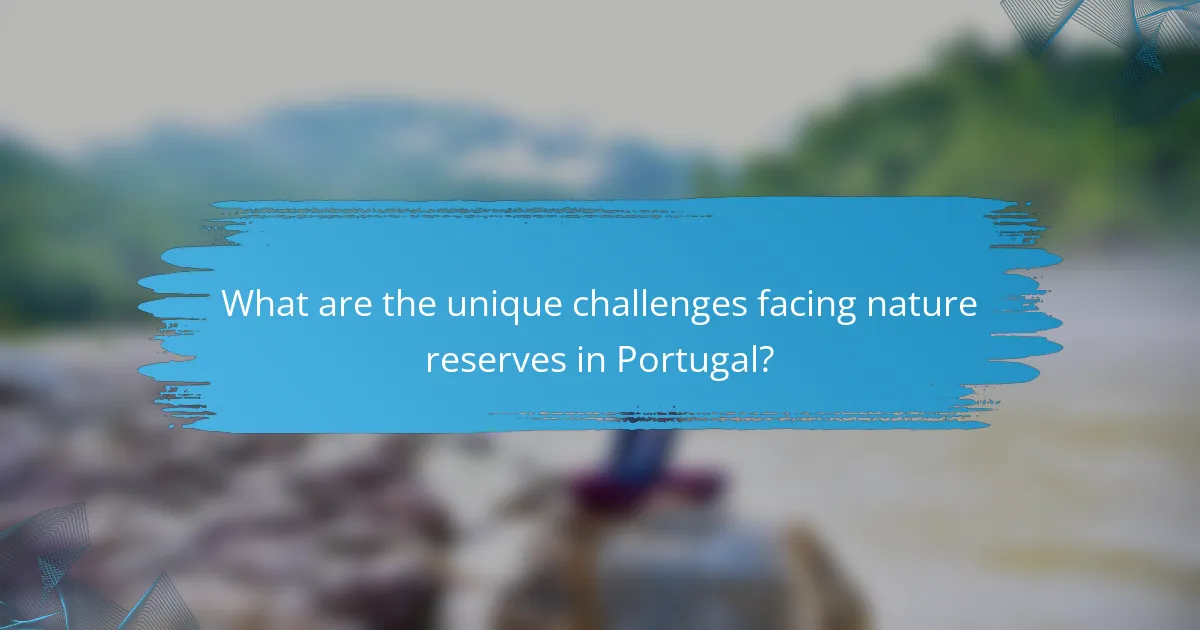
What are the unique challenges facing nature reserves in Portugal?
Nature reserves in Portugal face unique challenges including habitat degradation, invasive species, and climate change. These factors threaten biodiversity and complicate conservation efforts. Additionally, balancing visitor access with ecological preservation remains a significant concern. Effective management strategies are essential to mitigate these issues and protect Portugal’s natural heritage.
How do climate change and human activity impact these ecosystems?
Climate change and human activity significantly threaten Portugal’s nature reserves, impacting biodiversity and ecosystem stability. Rising temperatures and altered precipitation patterns disrupt habitats, leading to species migration and extinction. Human activities, such as urbanization and agriculture, further degrade these ecosystems by introducing pollutants and invasive species. Conservation efforts focus on mitigating these impacts to preserve unique attributes of local flora and fauna. As a result, maintaining biodiversity in these reserves is increasingly challenging yet essential for ecological balance.
What measures are being taken to address conservation challenges?
Portugal implements various measures to address conservation challenges in its nature reserves. These include habitat restoration, species monitoring, and community engagement initiatives. The government collaborates with NGOs and local communities to enhance biodiversity protection. Additionally, educational programs raise awareness about conservation efforts among visitors.
How can visitors contribute to the preservation of nature reserves?
Visitors can contribute to the preservation of nature reserves by following guidelines, participating in conservation activities, and supporting local initiatives. Simple actions include staying on marked trails, minimizing waste, and respecting wildlife. Engaging in volunteer programs helps maintain habitats and educate others. Financial contributions to local conservation projects also enhance preservation efforts.
What are the common mistakes to avoid when visiting nature reserves?
Common mistakes to avoid when visiting nature reserves include neglecting regulations, disturbing wildlife, and failing to prepare. Visitors should respect designated paths to protect ecosystems. Many reserves have specific rules about noise levels and littering, which are crucial for maintaining biodiversity. Additionally, not checking weather conditions can lead to unsafe experiences. Finally, underestimating the importance of local guides may result in missing out on unique insights about the area’s flora and fauna.